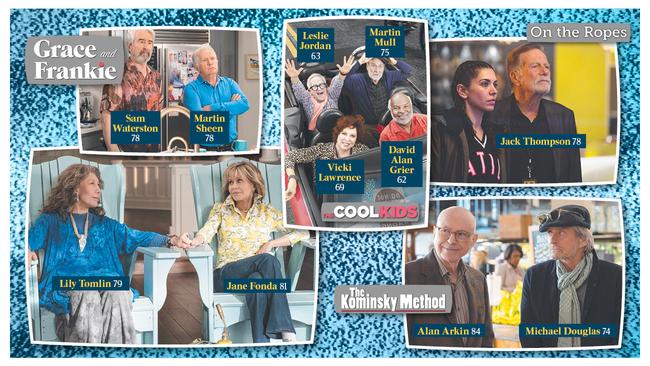Television’s golden years as programmers turn to older viewers
Long snubbed by the industry, older viewers are finally being catered to.

Hollywood has long been synonymous with the cult of youth. But a recent surge of television series indicates the entertainment industry has begun to rediscover older audiences, with shows featuring veteran actors and stories crafted to relate to their experiences.
Netflix’s The Kominsky Method, which recently won two Golden Globe awards, has plenty to say about both ageing and Hollywood.
One scene features 84-year-old actor Alan Arkin talking on the phone to 74-year-old Michael Douglas. Arkin’s character Norman, a talent agent and recent widower, is watching 1985’s Cocoon on television in his dressing gown. Douglas’s Sandy Kominsky, an actor turned acting coach, is gearing up for an ill-advised night on the town.
“The spaceship is taking the old people into space; that’s the happy ending for old people,” Norman says of the film’s finale.
“I remember seeing this in the movie theatre 30 years ago, but it’s a whole different thing when you are in the demographic.”
It is axiomatic that audiences relate most readily to characters who are similar to them. Yet for the sizeable ranks of the baby boomer audiences, it can seem as if the “old people” have been taken away in a spaceship, particularly when free-to-air television is considered.
According to a study from the University of Southern California, senior characters represented fewer than 10 per cent of all speaking roles in popular American TV series that aired in 2016 and 2017. And while the issues of diversity and representation in the Australian screen industry are discussed ad nauseam, the elderly feature well down the list, if ever.
Screen Australia’s landmark diversity report, Seeing Ourselves, looked only at the representation of cultural backgrounds, disability status and sexual orientation or gender identity. Events such as last year’s Diversity Showcase adopted the same categories. The Screen Diversity and Inclusion Network, which features 22 local member organisations, is the rare exception mentioning age in its charter.
Part of the explanation is undoubtedly the relative lack of attractiveness of older viewers to advertisers, who covet the 18 to 34 demographic and its discretionary spending. But Australian viewers aged 65 and older spend about three times as much time every month watching broadcast television on in-home TV sets as 18 to 34-year-olds, according to OzTAM and Regional TAM data.
It is a similar story in the US, where Nielson reports viewers 65 and older spending twice as much time watching TV a week as 18 to 34-year-olds.
And as viewers shift towards subscription television, and streaming video on demand in particular, the need to appease advertisers has receded, giving rise to a growing catalogue of programming such as Netflix’s Grace and Frankie, which began its fifth season last week.
It stars screen veterans Lily Tomlin (79), Jane Fonda (81), Sam Waterston (78) and Martin Sheen (78). By comparison, they are between 15 and 30 years older than the cast of The Golden Girls when it premiered in 1985.
The characters in Grace and Frankie struggle through daily life forgetting facts, losing objects and railing against their decreasing independence with a sense of humour and camaraderie.
“Yet another person who treats us as though we are enfeebled, incompetent and need to be saved,” says Fonda’s character, Grace, after discovering that her children have sold the home she shared with her friend Frankie after putting them both in a retirement home. (The duo escape the latter in a golf cart and resolve to squat in their former property.)
The series is perhaps even more remarkable for having two actresses receiving top billing, in an industry famous for its obsession with youth. It recently has been renewed for another season, as has Kominksy.
Netflix declined to comment for this article. But a focus on mature viewers has long been a hallmark of Foxtel, majority-owned by News Corp, publisher of The Weekend Australian.
Brian Walsh, executive director of television at the subscription TV provider, says financially strapped commercial free-to-air stations have all chased the lowest common denominator of viewer.
“I am of the view that the older demographics are generally under-served on Australian television and so, yes, we absolutely see this audience as an opportunity for us.
“Australians are living longer and enjoying entertainment more than ever,” says Walsh.
“In creating our series we look to build shows that have broad appeal and create viewing opportunities that are multi-generational, and we’re seeing that with series such as A Place to Call Home (Foxtel’s top-ranked show last year in the age group 65 and older).
“The clear advantage Foxtel has over our competitors in both the streaming space and free to air is that we have the bandwidth and the channel capacity to provide enormous choice and something to suit everyone.”
A new sitcom titled The Cool Kids recently began screening on Foxtel’s Fox8 channel, starring Will & Grace’s Leslie Jordan, along with Martin Mull, Vicki Lawrence and David Alan Grier.
It exploits the comedic potential of people in a retirement home with varying degrees of maturity and unlimited free time on their hands.
Foxtel’s BBC First channel, which launched in 2014, is particularly popular with older viewers according to Tim Christlieb, director of BBC Studios Australia and New Zealand.
“It’s the continuous delivery of the underlying BBC titles — Death in Paradise, Call the Midwife and Silent Witness — that provide our core viewers, the hugely loyal 55-plus audience, with their fix of fresh, original British drama,” he says. “It’s an audience we believe are somewhat under-served by other channels and offer BBC First a distinct point of difference.”
As a public broadcaster, the ABC is free of the need to please advertisers, yet it has come in for recent criticism for neglecting older audiences.
Australian actress Nadine Garner recently told this newspaper that she thought the ABC’s cancellation of The Doctor Blake Mysteries — a ratings juggernaut — was “the true mystery that will never be solved”. The series was cancelled in 2017 before allegations of harassment and sexual misconduct were made against the show’s star, Craig McLachlan, early last year. It has since been rebooted by Channel 7 without him as The Blake Mysteries.
“They were so hellbent on finding audiences under 30, they thought somehow Doctor Blake was too conservative, not progressive enough, not multicultural enough, and only for older audiences. The ABC was extraordinarily indifferent to us,” Garner says.
The broadcaster responded to the criticism, claiming the show “enjoyed exceptional support” from the ABC across a five-year run.
“Any suggestion that the ABC did not support the program or does not cater for older audiences more broadly is incorrect,” an ABC spokesman says.
“The ABC is the home of outstanding Australian dramas that appeal to audiences of all ages and interests, such as Mystery Road, Jack Irish and Harrow. Equally, our international acquisitions such as Killing Eve and Vera attract mass audiences, due in no small part to their popularity among older viewers.”
Though there are signs of increasing demand for older actors, on streaming in particular, supply may be another issue.
Ill health and death thin the ranks as inexorably for actors as for every other profession. Some such as Jack Nicholson are rumoured to have retired because of the inability to remember lines. Others, such as Chevy Chase, who starred in NBC’s Community, have been said to complain about the arduous hours on set. Other actors simply may wish to retire and not work into their 60s, 70s or 80s.
Jack Thompson (78) is perhaps the oldest Australian actor still working on TV, and recently starred in the SBS series On the Ropes. He told The Daily Telegraph that he had contemplated retirement in the past, but too many rewarding roles were available for performers of his vintage.
“As a young actor, you get a lot of work presented to you, you’re the hero. Now you are slightly older … you are the hero’s uncle,” he said.
“When you start to become truly senior, these roles are presented to you. You are the old man now. And I don’t mind being the old man. It’s quite a good thing to be able to bring to the screen and they are interesting roles.”




To join the conversation, please log in. Don't have an account? Register
Join the conversation, you are commenting as Logout